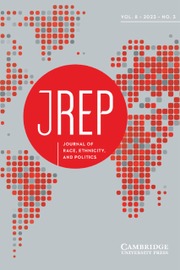No CrossRef data available.
Article contents
Views on Men Behaving Badly: Male Public Opinion and the 2021 Capitol Insurrection
Published online by Cambridge University Press: 17 March 2025
Abstract
While the majority of 2021 Capitol insurrection participants were white men, the media prominently highlighted the involvement of male conservative activists of color. However, we still know little about the perspectives of men in the general public regarding this event in our nation’s history, particularly across racial/ethnic and other identity groups. This project examines the influence of racialized anger and racial efficacy on self-identified male views toward the 2021 Capitol insurrection across racial/ethnic groups. We utilize the 2020 Collaborative Multiracial Post-Election Survey (CMPS), which was the only national, post-election dataset to yield responses on the Capitol insurrection across a large number of identity groups like men of color. Using the CMPS, we hypothesize that the level of racialized anger and racial efficacy will impact attitudes toward the 2021 Capitol insurrection for men across racial groups comparing men of color and their white male counterparts. We find racial anger has a negative effect on political attitudes about the 2021 Capitol insurrection across all groups of men, while racial efficacy has varied effects on certain men of color groups in comparison to white men. This paper underscores the importance of intersectionality in the study of public opinion formation and the effect of political attitudes like racial efficacy and racialized anger on non-traditional political engagement.
- Type
- Research Article
- Information
- Copyright
- © The Author(s), 2025. Published by Cambridge University Press on behalf of The Race, Ethnicity, and Politics Section of the American Political Science Association


